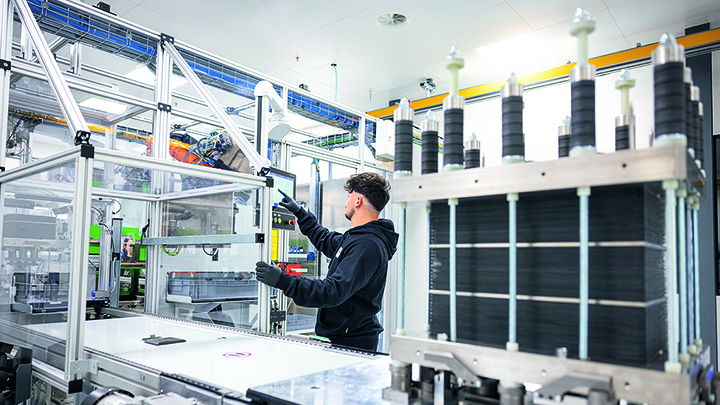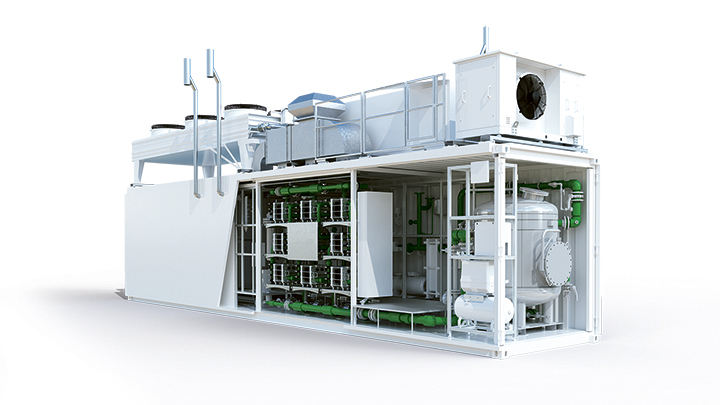A state-of-the-art system for processing cylinder heads is currently being put into operation in Augsburg – a further contribution to securing the site’s future.
A conveyor system takes cylinder head blanks from a rack and transports them automatically to one of four mill-turn machining centers, where they are literally given the final polish. In the current phase of the start-up, six employees operate this powerful system, make sure that the right machining programs are used or measure the tolerances when required. This flexible manufacturing system (FMS) lives in Hall A2 in Augsburg, where it is helping to ensure that cylinder head production is innovative, competitive and future-proof.
Old machines, high risk
Just a few months ago, the space was filled with around 35 machines from other areas of production, all of which had to be moved or partly dismantled during operation. Seven systems, all with at least two decades on the clock, were being used for cylinder head production. The age of the machines meant that there was a high risk of malfunctions, and important spares like control components and electronics were extremely difficult to come by. “Aside from that, the machines had very limited redundancy. In other words, if a machine malfunctioned, we could not simply replace it with another. The old systems came from different manufacturers, as well as all having a different technological focus, being built at different times and using different operating supplies and toolholders. When you realize that cylinder heads are among our core components, it becomes apparent that we have been walking a tightrope in this respect for a long time,” says Reinhard Ried, Head of Large Component Production. A further reason for putting cylinder head production on a completely new footing lay in the fact that its division between three production/assembly islands in different parts of the shop floor, which had come about over time, was resulting in long lead times and substantial logistics costs. And last but not least, the old machines were no longer able to keep pace with modern automation and digitalization requirements. The time had therefore come for a brand-new set-up.


Biggest single investment in Augsburg
It was back in 2021 that the Executive Board approved nearly EUR 20 million – one of the biggest single investments ever made in Augsburg – for the flexible manufacturing system, the start-up of which has been in progress for several months. “The greatest challenge has been implementing the project while we are very busy,” says Thomas Roth. He is in charge of component production for engines and can well remember how complicated it was for colleagues from Planning and Production to prepare an area of 4,700 m² during operation. “We have only been able to achieve such high-quality results because humans and machines worked hand in hand so to speak over a period of 18 months.”
A question of cost-effectiveness
The decision to acquire the manufacturing system was preceded by intensive consultation and a lot of calculating. Before the Executive Board approved the investment, colleagues had to prove that production costs would be competitive with the investment. The alternative would have been to have the cylinder heads produced externally in future and so lose a core component at the Augsburg site. It turned out, however, that cylinder heads are difficult to source externally because of their complexity. They also contribute to capacity utilization in the foundry and provide the basis for our license, service and retrofit business. So there were plenty of good reasons to invest in a brand-new manufacturing system.
We no longer speak of machine operators, but system operators, who are being given exciting new tasks, not least as a result of increasing digitalization.
Changing jobs
The targeted automation of cost-intensive processing steps is only possible with a concept involving multiple machine work and operating time with minimal manpower. New clamping and tool concepts optimize processing times, while large workpiece and tool magazines reduce set-up and nonproductive times. Rack feeders and manipulators improve ergonomics and occupational safety. “All in all, this approach is helping enormously to cut lead times and boost plant efficiency, thereby reducing production costs. At the same time, jobs are undergoing significant upgrading. We no longer speak of machine operators, but system operators, who are being given exciting new tasks, not least as a result of increasing digitalization,” says Tobias Gruber, Segment Manager Cylinder Head Production.
Next big project just around the corner
For Head of Site Wolfgang Walter, the new cylinder head production is a magnificent collective achievement and an important investment in the Augsburg site. Upgrading the testbeds for operation with new fuels like methanol or hydrogen and modernizing the machine shop in the Training Center also fall into this category, of course. Incidentally, the next big project is already in full swing: “In January, we will start on the foundation work for a new portal machining center for engine blocks in Hall C3. The new Waldrich-Coburg Gantry 3 will replace the Aschersleben machine, which is nearly 30 years old. Production is scheduled to start in the first quarter of 2026,” Wolfgang Walter explains. So there will be lots to do at the Augsburg site in future too.
Explore more topics
-

Zurich compressor technology minimizes footprint
MAN ES is supplying two electric HOFIM® compressor systems for gas storage facilities in Italy – Zurich’s state-of-the-art compressor technology will help to reduce emissions.
-

Milestone for green hydrogen economy
Quest One – formerly H-TEC SYSTEMS – is going to manufacture PEM electrolysis stacks in Hamburg using highly automated series production. These will play a key role in ramping up the hydrogen economy.
-

Power-to-hydrogen for Finland
MAN ES is building a production plant for green hydrogen in Helsinki together with Quest One.
